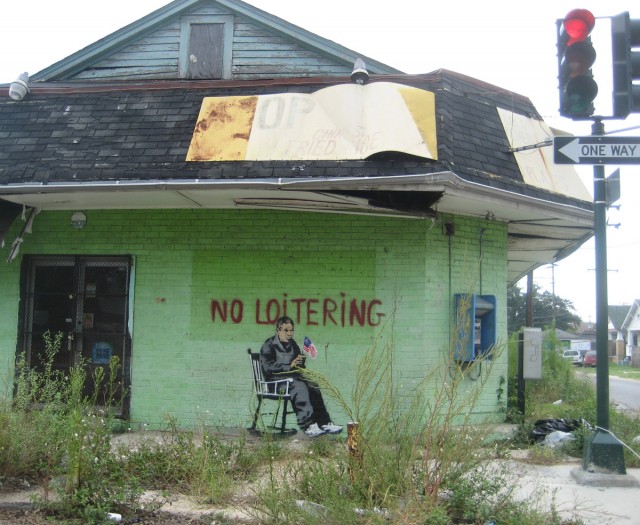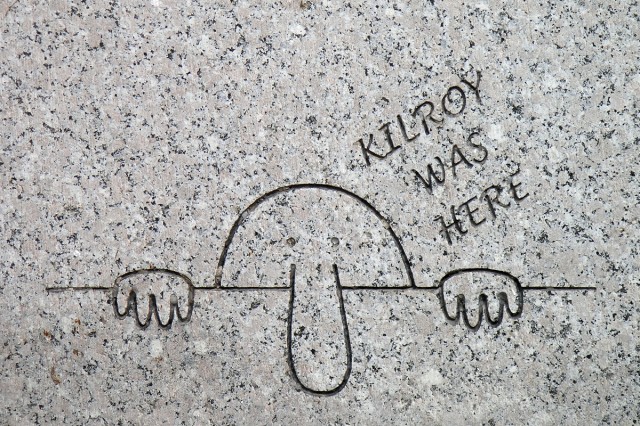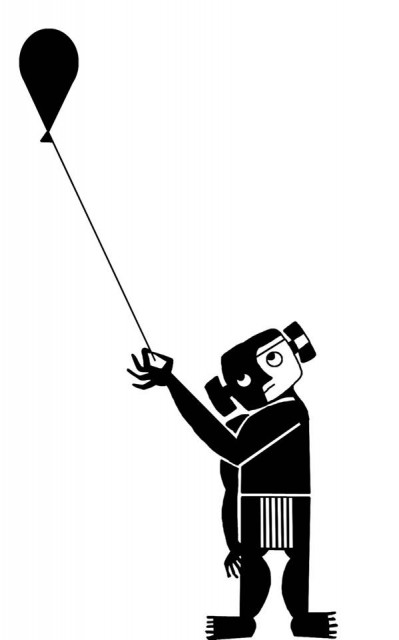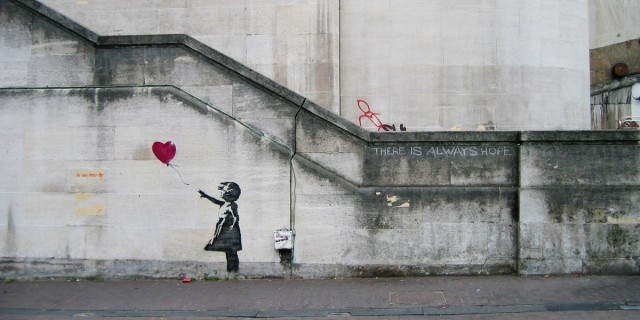- Home
- >
- Preservation Archaeology Blog
- >
- Creepytings versus Rock Art and Banksy
One of the things I like best about studying human behavior is exactly how confusing human behavior can be. What we do as archaeologists, anthropologists, sociologists, human geographers, and/or historians is much less like the frequently used jig-saw puzzle analogy and far more like a drunken game of Tetris with different rules in different parts of the screen and the occasional round object thrown in for good measure. Case in point for confusing human behavior:
There once was a young woman—decked out in the latest, expensive fitness gear—who traveled around the American West and painted signed images within various park boundaries under the name Creepytings (as of today, the suspect has been officially named as Casey Nocket of New York state). You may have read about it on Southwest Archaeology Today, at various news agencies, or on modernhiker.com, the website that first broke the news.
View examples of Creepytings’s graffiti at www.modernhiker.com.
There are a number of things going on here that make this situation confusing. Besides the mind-bender called human nature, another is the equally confusing nature of art (and in this case, it is also art in nature, as it were). If you go to any of the above links, or just Google “national park vandal,” you’ll find a number of articles about this vandalism, and a bit about the nature of art.
What I would like you to do—and I’m sorry for this, I really really am—is to jump down the rabbit hole. Yes. I’m actually going to ask you to read the comments. I know that is normally a huge mistake and most people, if they ignore the voice in their head screaming at them to not scroll down the page anymore, end up curled in a ball questioning their sanity at best and their humanity at worst (or vice versa). However, and maybe surprisingly, outside of the few crazies calling for violent acts against this woman, there are legitimate voices within the crowd that are arguing over the validity of her actions.
And these arguments, I think, really revolve around the very nature of art. So I’m going to give you my thoughts as an archaeological anthropologist on this event, on the type of art it is most frequently being compared to (street art/graffiti and Native American rock art), and then I’ll follow up with some comments from people I know in the art community.
There are two main arguments that are being slung around these paintings. One is that the woman is an artist and she is doing the equivalent of street art. This is highlighted in the Denver Post article where the author calls her a sort of Banksy of the wild. This is where things get confusing, because the people who are equating her work in the wilderness with street art are conflating the simple act of vandalism (which I don’t think is that simple and I’ll get in to that in a bit) with street art.

Art as vandalism is important, but it’s the intention that is even more significant. Or, more essentially, the social context of the painter. There is meaning behind this woman’s painting, and she might not understand exactly what it is, but it is there. To understand this meaning, though, we need to talk a bit more about street art.
At its very core, street art is about resistance. It is about projecting power into a void of power, into a world where you feel powerless. It’s about claiming control when you feel you have none, of giving the voiceless an avenue to be heard. Unsurprisingly, street art is often a path of opposition for beleaguered ethnic and class groups. The oppressors are not necessarily simply the government, but those who either unabashedly or unknowingly profit from cantilevered social and political relationships. Those who profit from structural inequalities. In essence, those who have privilege.
Anyway, street art is an expression of outrage shouted out, sometimes with fear, often times with anger, but frequently with love as well. It lets people know that you can do something. You can act. That regardless of the current situation, you are human and you have power. You can reclaim your deteriorating neighborhood and make something beautiful amongst the detritus of despair. You can place a sign for all of the public to see that you exist and that you are important. You can rally to a cause or point out societal problems. In short, street art is a weapon. Or maybe I should say street art, when used effectively, is a form of activism.
Not all street art is the same, of course. Any trip down an urban corridor will show that. Graffiti can also be from gangs marking their territory, as well as holding hidden but public conversations. Or it could be other taggers simply marking their presence (which, while it is much less often considered art, can still move into the realm of art—and even legend, as did James J. Kilroy with Kilroy was here.

The important thing, though, is that vandalism as art is confronting or questioning (or both) the current power structure. This woman was not wielding her art as a weapon to assail her position in society, to call in to question our unquestioned positions of class and affluence in this country that allow for little to no upward mobility. She was not the resistance questioning and pushing against the domination of an elite. In many ways, it is the reverse. She is in a position of privilege. (I’m inferring, based on her expensive exercise gear and her extended vacation through the west from New York state, that she is not in a position of poverty). If you are in a position of power and you are using vandalism as art, you are saying a far different thing than those who have no other outlet and are trying to be heard.
In the case of Creepytings, what we have is vandalism as art that is coming from a position of power. This is not street art. Street art inverts the normal power dynamic, questions inequality, and an authority that allows institutionalized inequality. When street art comes from a position of privilege, it inverts its original meaning. Instead of questioning power disparities, it reinforces them. So, for me at least, this is not a case, as is street art, of questioning the status quo of unequal social and political power structures. Instead, it’s a case of enforcing the status quo. Is this woman an artist? Sure. Is what she doing art? Sure. Is it the same as the street art she is trying to copy? No.
Within that usurpation, Creepytings (itself a name appropriated from a dialect—”tings” comes from Jamaican patois for “things,” a patois that came about through an admixture of languages during the colonial slave trade) repositioned her work into a place of power over instead of power against. Even more dangerously, this woman chose national parks and historic buildings as her canvas. Many of these parks are sacred landscapes for contemporary tribes. When you view her chosen canvases as sacred landscapes, then her paintings take on an even stronger tone of enforcing power over another group who have already suffered heavily.
The long-story-longer of this is that I’m not in a position to tell you if what she has done is art. I actually think it is, even as mediocre as it is. But that doesn’t make what she did right. As I’ve discussed, I actually think it makes it worse. Regardless of whether it is art, though, what she is doing with her drawings is producing an entirely different message than what many of her supporters imply when they link her with urban street art. It is art with a message of entitlement and privilege—of mine, not yours.
I’ll share some conclusions in part 2.
|
|
|
2 thoughts on “Creepytings versus Rock Art and Banksy”
Comments are closed.



Incredibly well written and insightful. Thank-you for taking the time to share this and the implications of the action in all of our lives, both the marginalized and the privileged.
-Focus